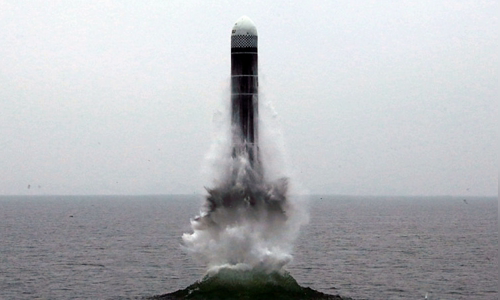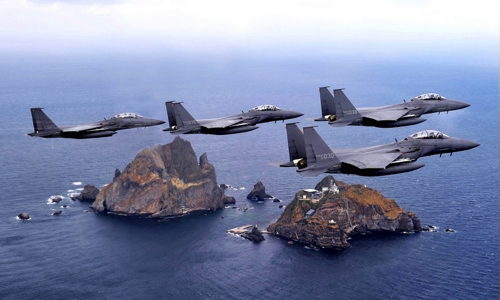The Gulf region has become a hotspot for confrontation with the US-Iran, while the Korean peninsula is also tense because of a series of Pyongyang missile tests.
Iran downed US drone

The Pukguksong-3 missile was launched by North Korea on October 2 Photo: KCNA
Iran's Islamic Revolutionary Guards on June 20 shot down an American RQ-4N Global Hawk (UAV) RQ-4N Global Hawk with allegedly violating Iranian airspace in the southern region of Hormuzgan and declares it here. is the clear message to America.
The Pentagon later confirmed the loss of a RQ-4N BAMS-D surveillance plane costing more than $ 200 million, confirming the aircraft was shot down while operating in international airspace.
This is considered a heavy loss for Washington, marking the first time a variant of the Global Hawk line was shot down in 18 years of operation, significantly reducing reconnaissance capacity in the Middle East and causing many countries to be suspicious. about US UAV features.
The incident pushed US-Iran relations up a new tension ladder, adjacent to the crater of war. US President Donald Trump ordered an air strike against Iran, but withdrew his decision at the last minute to avoid escalating tensions. The White House boss then increased pressure on Iran by supplementing economic sanctions with Iran's supreme spiritual leader Ayatollah Ali Khamenei and senior Iranian officials.
Turkey receives Russian S-400 air defense missile
The Turkish military in July began taking over the S-400 long-range air defense complex under a $ 2.5 billion contract signed with Russia two years earlier. Moscow transferred two complete S-400 systems to Ankara, one of which was deployed at the Murted base and tried to confront F-16 and F-4 fighters on the Turkish air force at the end of the month. 11.
The arrival of the S-400 missile in Turkey's payroll, a NATO member, could be a game changer. The US is concerned that the S-400's powerful sensors integrated into Turkey's air defense systems could eliminate the stealthy advantages of F-35 fighters, helping Russia collect valuable intelligence data. price.
Turkey rejected these concerns and decided to accept the S-400 despite threats from the United States, straining relations between Ankara and Washington. The United States has removed Turkey from the F-35 super fighter program, refused to hand over 105 F-35As it ordered and removed Turkish defense corporations from the generation of stealth fighter production. 5. Washington also left open the possibility of punishing Ankara under the provisions of the US Anti-Rival Act Through Sanction Orders (CAATSA).
Turkey responded sternly, announcing its readiness to close two strategic US air bases in the territory and expressed its readiness to buy more S-400 missiles to strengthen its defenses.
North Korea repeatedly tested weapons
North Korea this year tested a total of 13 weapons, firing many newly developed weapons such as short-range ballistic missiles that look like the Russian Iskander model, super large rocket artillery, a similar tactical missile system American Army Tactical Missile (ATACMS) and ballistic missiles launched from the Pukguksong-3 submarine.

Korean F-15K fighters fly over the Dokdo / Takeshima island group Photo: RoKAF
These consecutive weapons tests help North Korea perfect the weapons capable of penetrating enemy defenses, significantly improving short-range offensive capability. However, they have also added to tensions on the peninsula, and show Pyongyang's impatience in the context of non-nuclear talks with the US at a standstill.
Pyongyang also conducted two important tests at the Sohae satellite launch site in December, saying it would help strengthen its nuclear deterrent capabilities and change its strategic position. This, along with tough statements about "Christmas gifts" and the deadline for negotiations with the US at the end of 2019, made experts worried that North Korea might launch intercontinental ballistic missiles (ICBMs), even is to test nuclear weapons in the near future.
The US - Russia terminates the INF Treaty
The US and Russia announced on August 2 that the Intermediate-Range Nuclear Forces (INF) Treaty was over and blamed each other for the collapse of the deal.
The INF was signed by the United States and the Soviet Union in 1987, which forbade the two sides to develop all types of ground-launched cruise and ballistic missiles with a range of 500-5,500 km. The United States accuses Russia of violating the agreement when developing the Novator 9M729 missile with a range of more than 5,000 km. Moscow confirmed its range was 480 km and did not violate the treaty, and said that Washington broke the INF by placing Aegis Ashore complexes capable of launching Tomahawk cruise missiles in Europe.
Shortly after withdrawing from the deal, the United States twice tested missiles with a range of more than 500 km, while Russia also announced it was willing to convert a wide range of launch missiles from aircraft and submarines. ground. Many countries fear this will open a new arms race, putting Europe in the sights of a variety of nuclear missiles.
The US unexpectedly withdrew its troops from Syria
The White House announced the withdrawal of all U.S. troops from northern Syria on October 7, before Turkey launched a Spring Peace military campaign against Kurdish militia in the region.
President Donald Trump's decision suffered criticism from many sides, including the Syrian Democratic Forces (SDF) with the core of the Kurdish militia and his supporters. Most consider it an act of betraying the leading US ally in the fight against the Islamic State (IS), seriously destroying the credibility and reliability of the United States, and at the same time creating conditions for IS. rise.
In response to the public's opinion, Trump then changed his mind, claiming to maintain 600-700 soldiers in Syria, with the main goal of protecting oil fields in the eastern part of the country and continuing the fight to stop IS. rise.
However, Trump's decision to withdraw also significantly changed the situation of the battlefield in Syria, paving the way for Russia and Turkey to reach an agreement to jointly control a large area in the northern part of the country. when American influence was greatly reduced.
Korean fighters fired Russian bomber strikes
South Korea on July 23 accused the squadron of two Tu-95 bombers and a Russian A-50 early warning aircraft entering the air defense identification zone (ADIZ) of this country in the East China Sea, of which The A-50 flew into Korean airspace over the disputed Dokdo / Takeshima island group with Japan.
The South Korean fighter then fired 360 shots warning Russian aircraft, which were participating in a joint training with Chinese bombers in the East China Sea. Japan has also deployed fighters to monitor the activities of Russian and Chinese bombers.
The shooting was an unprecedented confrontation in the East China Sea, involving military aircraft from four "giants" in the region including Russia, China, Japan and South Korea. The fortunate incident did not lead to any unfortunate incident, when all countries' aircraft returned safely to the base. However, the confrontation between 4 "big" then continued on the diplomatic front.
Experts say South Korea reacted toughly to the encounter to show its claim to the Dokdo / Takeshima island group against seemingly intentional moves by Russia and China.
The incident comes in the context that Beijing is promoting military operations in Northeast Asia to show its ability to deploy power far from the mainland. Moscow has also increased long-range patrol flights in the Pacific, including being present in areas near US airspace in recent years.
Chinese aircraft carrier Shandong
China held a payroll ceremony for the domestic carrier Shandong at Sanya base on Hainan Island on December 17. Chinese media praised the payroll of the Shandong ship as a "milestone" in an effort to build naval power, helping Beijing close the gap with Washington.
The Shandong ship was built in 2015 based on the design of Liaoning, the carrier was bought by Ukraine from Ukraine in 1998 and converted and put into operation in 2012. China originally planned to staff the Shandong at the beginning of the year. 2019, but a series of incidents during the test made the delivery schedule delayed by 8 months.
Military experts point out that Shandong still has significant weaknesses in its design and tactical characteristics, making it impossible to operate for long periods at sea and to be significantly limited in combat. These restrictions make it difficult for Shandong aircraft carriers to become sharp weapons, but will be a tool to help China "show off" and increase the risk of confrontation in the South China Sea.



 JuvelynLicaros
JuvelynLicaros








